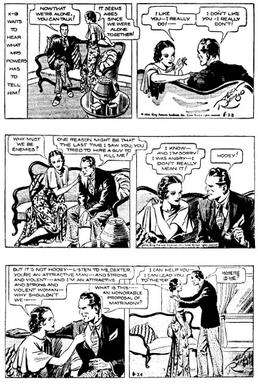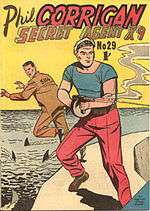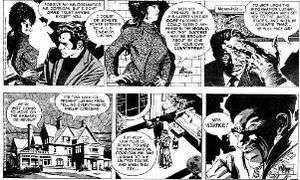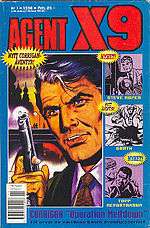Secret Agent X-9

Secret Agent X-9 was a comic strip created by writer Dashiell Hammett (The Maltese Falcon) and artist Alex Raymond (Flash Gordon). Syndicated by King Features, it ran from January 22, 1934 until February 10, 1996.
Premise and publication history
X-9 was a nameless agent who worked for a nameless agency. X-9 used the name "Dexter" in the first story ("It's not my name, but it'll do.") and kept using it or being called by it in later stories, but acquired the name "Phil Corrigan" in the 1940s and decades later the strip was renamed Secret Agent Corrigan. The nameless agency was also briefly the FBI when the FBI was in vogue, but when the FBI became less popular, references to it were dropped and the agency was nameless again.
After four stories by Hammett, Alex Raymond illustrated two stories written by Don Moore and one written by Leslie Charteris. Charteris continued to write three more stories, illustrated by Charles Flanders. After Charteris left the strip in 1936, scripts were credited to a King Features house name, "Robert Storm". Who did the actual writing is unknown. Nicholas Afonsky drew the strip for most of 1938, followed by Austin Briggs until 1940. Mel Graff took over the art in 1940 and began writing the strip as well in 1942. Graff is the one who gave X-9 his name, Phil Corrigan. Graff thought it didn't make sense for a secret agent to be addressed by his secret moniker, X-9. The name Phil Corrigan was inspired by Phil Cardigan, a character in one of Graff's earlier comic strips, The Adventures of Patsy. Graff also gave X-9 a more personal life with romantic interests Linda and Wilda. Both these characters inspired popular songs: "Linda" written by Jack Lawrence and "Wilda" written by Graff himself. Wilda became Phil Corrigan's wife.
Graff was followed by artist Bob Lubbers, who used the pseudonym "Bob Lewis" and drew the strip from 1960 through 1966. From 1967 to 1980, the strip was written by Archie Goodwin and drawn by Al Williamson, who together also collaborated on the Star Wars comic strip. The last artist on the strip was veteran George Evans, who wrote and drew the strip from 1980 to his retirement in 1996.
In 2000–2001, X-9 made a guest appearance in the Flash Gordon Sunday strip. One page was drawn by Evans, and that was X-9's last appearance in newspaper comics.
In comic books

United States
The only original comic book story with X-9 produced in the U.S. was a serialized story that ran as a back-up feature in the Flash Gordon book. Five parts of five pages each were published in Flash Gordon #4–8 (1967). The first part ("The Key to Power") was written by Goodwin and drawn by Williamson; this apparently got them the job as creators of the newspaper strip. The other parts of this story were
Scandinavia and western Europe
Secret Agent X-9 has had a long history in European comic books. Most notably in the Agent X9 series of comic books in Scandinavia. The magazine started in 1969 under the title X9 in Sweden. As often is the case with European comics, it was an anthology magazine that also included many other comics. In the first issue, X-9 was joined by Jungle Jim and The Phantom. In the early 1970s Modesty Blaise followed and has since been the main comic of the magazine; despite the name Agent X9 the strip Secret Agent X-9 does not appear in every issue, though it remains the only comic to be consistently published in the magazine since the start.
The Agent X9 magazine was for a long period published in Sweden, Norway, Denmark and Finland. Short-lived editions were also published in the Netherlands and West Germany. As of 2017, only the Swedish and Norwegian editions remain in production.
During the 1980s, the Agent X9 editors requested more Secret Agent X-9 material from King Features since the newspaper stories were quickly published (despite the fact that the strip didn't appear in every issue any more). King Features then began to supply the magazine with exclusive Secret Agent X-9 stories, that have never been published elsewhere. Although these stories were made directly for comic magazines, they were produced in the regular daily strip format. Perhaps so they could have been used for the newspaper strip also, but that never happened. The following produced stories for the Agent X9 magazine:
- Joe Gill (script) and Jack Sparling (art): two stories (1983)
- M. Gill (script) and Miguel A. Repetto (art): 30 stories (1985–1995)
- Dean Davis (script) and John Dixon (art): 16 stories (1997–2003)
- Mike W. Barr (script) and Mike Manley (art): two stories (2007–2009)
Unlike the previous stories, the Barr & Manley stories did not use a classic daily strip format.
Australia
An Australian comic book, Phil Corrigan: Secret Agent X9, was published by Atlas Publications between 1948 and 1956. It featured reprints of the newspaper strips.
Films

Secret Agent X-9 was the subject of two film serials in 1937 and 1945. In the first Agent X-9 movie, Scott Kolk played Agent Dexter (not Phil Corrigan) aka Agent X-9, it was based on the "X-9" character who replied in the fifth day of the daily strip in January 1934, "Call me Dexter. It's not my name but it'll do." The classic 1930's serial follows the adventures of Secret Agent X-9. One of his top assignments is to recover the crown jewels of Belgravia and to capture master thief Blackstone. Along with Shara Graustark (Jean Rogers), who has her own reasons and agenda for helping him, Agent Dexter/X-9 investigates.
The film Secret Agent X-9 (1945) starred a young Lloyd Bridges as Phil Corrigan/X-9. The serial progress through 13 chapters, this time American, Australian and Chinese agents join forces against the Nazis and Japanese to uncover and possess the formula that will help create a synthetic aviation fuel, code-named "722". Keye Luke co-starred as Chinese agent Ah Fong, Jan Wiley as Australian agent Lynn Moore, Victoria Horne as Japanese master spy Nabura and Benson Fong as Japanese scientist Dr. Hakahima. In this serial, the alliance of America, Australia and China is referred as the "United Nations"; it pre-dates the actual United Nations by only a few months.
Radio
Secret Agent X-9 was adapted as a BBC radio drama and broadcast on BBC Radio 7 in January 2009. Secret Agent X-9 starred Stuart Milligan as "X-9" and Connie Booth as "Grace Powers". There were four episodes, adapted by Mark Brissenden and directed by Chris Wallis.
Reprints
In 1976, Nostalgia Press published a trade paperback reprinting many of the early Hammett/Raymond strips, with an introduction by Bill Blackbeard. In 1983, International Polygonics, LTD. (IPL) published a trade paperback edition (ISBN 0-930330-05-6) of the original Dashiell Hammett/Alex Raymond strips that included an additional story scripted by Leslie Charteris (Creator of the Saint) and a forward by William F. Nolan, author of Hammett: A Life on the Edge. In 1990, Kitchen Sink Press did a single volume reprint (ISBN 0-87816-077-9) of the Hammett/Raymond work on the strip. Comics Revue magazine has reprinted many of the George Evans strips, and also many of the Goodwin/Williamson strips. From 2010 to 2013, IDW published the Archie Goodwin/Al Williamson strips complete in five volumes in their series "Library of American Comics". A sixth volume collected strips by George Evans. In 2015, IDW published a volume with the Hammett/Raymond strips.
Media citations
- The ID of the "Agency Director" in the 1975 TV movie Columbo: Identity Crisis states Phil Corrigan, Agent X-9.
- The popular indie rock band, Modest Mouse, released a song entitled and about Secret Agent X-9 on their album Sad Sappy Sucker.
- In Kurt Vonnegut's novel Cat's Cradle, the character Franklin Hoenikker was known as Secret Agent X-9 in high school.
- Cartoon series Samurai Jack featured a film noir homage episode featuring a robot assassin X9.
- In Stephen King's novel Roadwork Secret Agent X-9 is mentioned.
- Former Secret Agent X-9 writer Archie Goodwin, in his 1970s revival of DC Comics' Manhunter, tipped his hat to Agent Corrigan and to James Bond, by assigning the Manhunter character Interpol case-file number 007X9.
- In "Topsy Turvy World", a 3rd season story arc of Rocky and Bullwinkle, the agent who picks up the protagonists for Captain Peachfuzz, now working at the Weather Bureau, is addressed as X-9.
Key facts
- Created by Dashiell Hammett and Alex Raymond
- Writers: Dashiell Hammett, Alex Raymond, Leslie Charteris, Max Trell, Mel Graff, Bob Lubbers, Archie Goodwin, George Evans
- Artists: Alex Raymond, Charles Flanders, Nicholas Afonsky, Austin Briggs, Mel Graff, Bob Lubbers, Al Williamson, George Evans.
See also
References
- Strickler, Dave. Syndicated Comic Strips and Artists, 1924–1995: The Complete Index. Cambria, California: Comics Access, 1995. ISBN 0-9700077-0-1.
External links
- Secret Agent X-9 at Don Markstein's Toonopedia. Archived from the original on September 13, 2015.
- Agent X-9 Page in Thrilling Detectives

